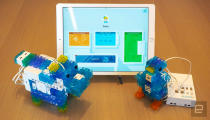Sony's Koov is a candy-colored coding course for kids
The first project from Sony's new education division makes robot construction super simple and fun.
STEM skills are in high demand right now, making toys that teach science and engineering popular with parents hoping to give their kids a leg up in the job market. Products like Hasbro's new robot that teaches coding have joined kits like Lego Mindstorms on store shelves. Now Sony is making its own plunge into STEM education using the Koov robotics kit, with decades of design experience being put to work in the hopes of training the next generation of engineers.
Koov has a lot in common with Lego Mindstorms: Both are building sets that revolve around taking a core processing unit and attaching motors, sensors and unconnected colored blocks to it, with the assembled robot programmed via an app. But Koov blocks are more cubelike, as each piece is designed around sets of four boxes reminiscent of Tetris. The proprietary design isn't just about being different, however. It means there are fewer pieces to manufacture, and it makes it easier for users to envision an idea as pixel art.

Those are just the standard "dumb" blocks, however. The core unit, motors and battery are solid white to stand out and shaped to accommodate their switches and ports. One thoughtful touch Sony added was the ability to separate the core processor and the battery pack. This means users don't always have to design their projects around a huge central unit.
Budding programmers can choose the starter kit, which gives kids some basic lights and sensors to use. Or they can get the advanced set, which steps things up a bit by adding gears, wheels and an accelerometer to the mix. All the pieces click together through pegs and holes placed at various spots on the blocks, which are a bit difficult to pull apart. No worries, though: Sony included a block separator.

While well designed, on a hardware level there's nothing particularly unique here. STEM products like littleBits' new Code Kit also give kids basic colorful components to put together simple games or robots. But those sets are also happy to just let users jump in, essentially saying, "Here are some pieces, here are a few examples of what you could do, now build something." That's fine for more-adventurous types, but what about aspiring builders who may feel intimidated by the amount of options and the learning curve?

The Koov app for iPad, Windows and Mac takes a slower, more measured approach. Instead of asking users to hop in, it takes small steps -- the first mission is actually called "What is coding?" And while this may be frustrating to kids itching to just build something, Sony wants Koov users to be cognizant of every step of the process. The instructions for each project include short animations showing where pieces go, and the 3D models can be rotated for a better look at how they're put together. Subsequent lessons walk users through how to use the motors, how to program lights and even how to properly balance their robots so they don't topple over.
The code is as easy to assemble as the physical blocks. In the coding screen of the app, commands are represented by colorful pieces that users can push together like a puzzle. The corresponding code is printed within each virtual block so kids can see how it works and gain practical knowledge that can be applied to coding in the real world.
Gradually Koov's lessons combine skills until kids are using every technique they've learned to build completely original creations. It focuses on creating a sense of comfort and fun, with colorful graphics and gamelike mechanics that give users a feeling of progress. You can also go back at any time should you need a refresher or don't fully understand something. It also doesn't punish you for not logging in every day. (Though in the future Sony may add some kind of reminder notification.)

Once kids are familiar with the basics of how everything works, they're ready to start creating their own robot recipes and putting them online. The social aspect is a big part of Koov. Users can share pictures and videos of their projects, explain what they did, and interact with other users in the comments. All uploaded projects will be vetted by an actual person, so parents don't have to worry about their children seeing something inappropriate (at least not on Koov, anyway). It also obeys the Children's Online Privacy Protection Rule (COPPA), a federal law that bans storing the personal information of children younger than 13. This is important given that the target audience for Koov starts at age eight. While younger children could give it a try, Sony feels that eight is the sweet spot for students to understand the concepts without feeling overwhelmed or needing a lot of help from their parents.

Right now there's not much to look at terms of projects, since it's only available in Japan. An English-language version is expected to ship in November, if the Indiegogo campaign that launched this week is a success. Kits are selling for around $300, but going the crowdfunding route also helps to stir up interest and lets Sony collect feedback before committing to a full retail launch. This is the first project from the company's new Global Education division, and the hope is that Koov will inspire the next generation of designers, builders and, just maybe, Sony employees.






















































